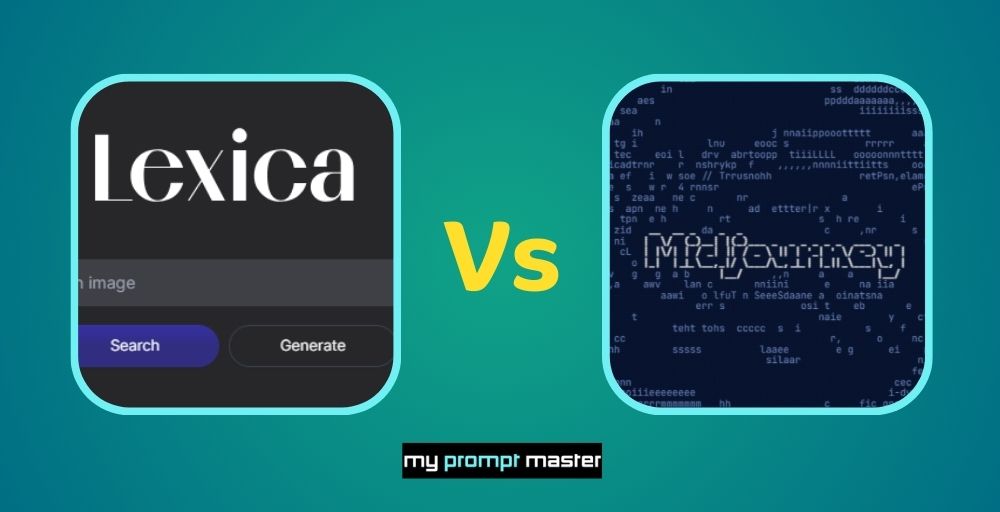Artificial Intelligence (AI) has made significant advancements in various domains, and one of the fascinating applications is AI-generated art. Two popular AI art generators that have gained attention for their unique capabilities are Lexica AI and Midjourney.
AI-powered art generators have gained immense popularity, allowing users to create stunning visual artworks by simply providing text prompts.

I will compare these two platforms in terms of their features, capabilities, and the types of images they can generate.
Introducing Lexica AI and Midjourney
Lexica AI and Midjourney are both AI-powered platforms that leverage text prompts to generate stunning images.
They have their distinctive features, making them popular choices among artists, designers, and enthusiasts.
Lexica AI
Lexica AI goes beyond a simple AI art generator; it doubles as an AI image search engine. This unique aspect allows users to explore a vast library of images based on their textual inputs.
Lexica AI offers personalized prompts that help users create more unique and tailored artwork.
Notably, Lexica AI provides a free search feature that returns a diverse array of images, making it an excellent tool for exploration and inspiration.
What’s even more impressive is its commercial usability, enabling artists to generate images suitable for commercial purposes.
Midjourney
Midjourney, on the other hand, shines as a Discord bot and within Discord channels. It stands out for its ability to generate usable artistic images even with relatively concise text prompts.
Currently in beta, Midjourney is available for free, attracting a broad user base eager to experiment with AI-generated art.
Moreover, Midjourney has earned a reputation as one of the best AI art generators available.
Its capacity to fill in additional details and deliver aesthetically pleasing outcomes with minimal input has endeared it to many creative minds.
A Comparison of Capabilities
Now, let’s delve deeper into the specific capabilities of each platform:
| Capability | Midjourney | Lexica AI |
|---|---|---|
| Image Generation | Discord bot or on Discord channels | AI Image Search Engine |
| Personalization | Moderate (Additional details with small prompts) | Highly Personalized (Customized photo generation) |
| Free Search Feature | Not Applicable | Available (Returns hundreds of images) |
| Commercial Use | Not Applicable | Permissible (Images can be generated for commerce) |
Midjourney: As a Discord-based AI art generator, Midjourney is best suited for users who prefer a seamless experience within the Discord ecosystem. It excels in generating a wide range of images, from landscapes to animals and even human portraits. Additionally, its remarkable ability to add intricate details with limited prompts has garnered praise.
Lexica AI: Apart from its image generation capability, Lexica AI impresses with its AI image search engine. Users can explore a vast collection of images, providing a valuable resource for artists seeking inspiration. The personalized prompts further contribute to creating distinctive artwork. Moreover, the freedom to use generated images for commercial purposes adds to its appeal.
Types of Images Generated
| Image Type | Midjourney | Lexica AI |
|---|---|---|
| Landscapes | ✓ | ✓ |
| Animals | ✓ | ✓ |
| People | ✓ | ✓ |
| Product Photography | ✓ | – |
| Customized Photos | – | ✓ |
Midjourney: This AI art generator covers a broad spectrum of image types. Users can generate breathtaking landscapes, captivating animal portraits, and lifelike depictions of people. Additionally, Midjourney is equipped for product photography, making it useful for commercial purposes.
Lexica AI: While it may not generate images explicitly for product photography, Lexica AI compensates with its vast image library, including landscapes, animals, and people. Moreover, its ability to produce customized photos tailored to users’ inputs sets it apart.
Frequently Asked Questions (FAQs) of Lexica AI VS Midjourney
What makes Midjourney stand out from other AI art generators?
Can I use the images generated by Lexica AI and Midjourney for commercial purposes?
How does Lexica AI go beyond image generation?
Conclusion
Lexica AI and Midjourney are both powerful AI art generators with unique features. Midjourney’s strength lies in its Discord integration and impressive ability to generate usable artwork with minimal prompts.
On the other hand, Lexica AI stands out with its dual role as an AI image search engine and a platform for highly personalized artwork.
The choice between these platforms depends on individual preferences and requirements.
Whether you seek commercial usability, personalized creations, or a diverse array of AI-generated images, both Lexica AI and Midjourney have something unique to offer. Embrace the world of AI-generated art and unleash your creativity with these remarkable tools!
